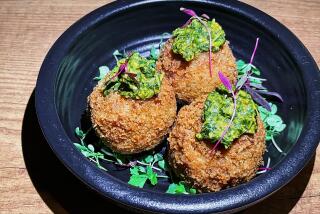The Second Banana : Versatile vegetable: You can fry it, bake it or boil it, but don’t try to eat the plantain raw.
- Share via
To the untrained eye, the plantain (accent on the first syllable) could easily be mistaken for a banana. But woe betide the unsuspecting eater who slices one onto his corn flakes! Shaped like a banana, smelling like a banana, the plantain is inedible in its raw state. But fry, boil or bake it and it becomes an epicure’s morsel.
I didn’t realize how popular plantains were until I moved to Miami. This jumbo cousin of the banana turns up at our ethnic grocery stores and mainstream supermarkets, at humble sandwich shops and exclusive restaurants, at ethnic eateries of a dozen nationalities. Tostones, tajadas, maduros and other plantain preparations are as popular here as French fries are in the North.
Plantains are among the most prolific of the carbohydrate crops. The same acre of land needed to grow 50 pounds of wheat or 100 pounds of potatoes can support two tons of plantains. “It’s an incredibly versatile vegetable,” explains Douglas Rodriguez, chef of Miami’s innovative new Cuban American restaurant, Yuca. “You can serve it as an appetizer, entree, vegetable or dessert; use it when it’s hard and green, soft and ripe, and at every stage in between.”
When green, the plantain is bland and starchy, like a yucca or potato. As it ripens, it becomes sweeter, tasting more and more like a banana. But even when fully ripe, it remains firm, which makes it very useful for cooking. As the name suggests, a green plantain has a hard, bright-green skin. A semi-ripe plantain (known as pinton in Spanish) will be uniformly yellow, while a ripe one will be mostly black. Like many tropical fruits, the plantain is at its sweetest when it is so ripe that it looks like you should throw it out. It takes six to eight days for a green plantain to ripen fully.
Fried plantains are popular throughout the Caribbean and Central America, where they often take the place of potato chips. Known as mariquitas in Cuba and tajadas in Nicaragua, plantain chips come about when you slice semi-ripe plantains lengthwise into paper-thin strips on a mandoline or meat slicer. These strips are deep-fried until crisp and served lightly salted.
Another popular plantain snack is tostones, thick diagonal slices of plantain, which are lightly fried, squashed in a wooden press that resembles a tortilla press, then fried again until crisp. Puerto Ricans dote on aranitas, literally “little spiders”--crisp fritters of grated plantain and garlic.
Besides being a popular snack, fried plantains are a starting point for many Caribbean dishes. Carmen Gonzales, Puerto Rican-born chef of a new Coral Gables restaurant called Clowns, makes pionones --paper-thin plantain strips rolled around ground beef and Caribbean spices. In another dish, Gonzales layers plantain strips with beef, green beans and cheese to make a sort of Puerto Rican lasagna.
Rodriguez also pulverizes mariquitas to make crumb coating for frying snapper. “Unlike potato chips,” he says, “fried plantains won’t burn, so they’re ideal for use as a breading.”
But green plantains are only part of the story. Go to any Cuban or Nicaraguan restaurant here and you’re sure to find maduros (literally “ripe ones”), dulcet deep-fried ripe plantains. Platanos en almibar is a popular dessert in Puerto Rico: ripe plantains poached in sugar syrup with a cinnamon stick. The mere mention of platanos a temptacion-- plantains cooked with sugar, rum and lemon juice--will bring a sparkle to any Cuban-American’s eyes.
Fortunately for health-conscious North Americans, not all Caribbean plantain dishes are deep-fried. Most of the Spanish-speaking islands have a version of mofongo, where mashed, boiled green plantains are flavored with garlic and onions. Mangu, mashed plantain with garlic and chicharrones (pork cracklings) or bacon, is a traditional breakfast in the Dominican Republic. In Cuba and Puerto Rico, chicken or beef broth is thickened with boiled plantains to make a comforting soup called sopa de platanos.
Plantains are more difficult to peel than bananas, especially when green. Rodriguez cuts the ends off the fruit, makes three lengthwise slits in the skin and soaks the plantains in ice water for a few minutes prior to peeling. He says the ice water helps firm up the starch. He then uses his thumbs to loosen and slip off the skins. Gonzalez peels her plantains under lukewarm running water to wash away the milky liquid under the skin.
Plantains are widely available, even in northern cities. Look for them in the produce section of a supermarket or in any store that caters to a Caribbean or Latin American clientele. Green plantains should be bright green, firm and free of blemishes. Semi-ripe plantains should have a yellow skin speckled with black. A plantain encased in a shriveled black skin will be sweet and delicious.
One cup of plantains contains 125 calories. Plantains are rich in potassium and Vitamin C.
These garlicky plantain fritters are a popular snack in Puerto Rico. Their spindly contours vaguely look like spiders. This recipe comes from Carmen Gonzales, owner and chef of the Miami restaurant Clowns.
ARANITOS DE
PLATANO
(Plantain “Spiders”)
2 green plantains
4 cloves garlic, finely chopped
Salt, pepper
Oil for deep-frying
Peel plantains as described and grate on coarse side of hand grater. Mix grated plantain with garlic. Season to taste with salt and pepper.
Heat oil to 350 degrees. Using 2 spoons, form 1-inch balls of plantain mixture and drop into hot oil. Fry 1 to 2 minutes, or until golden brown, turning with skimmer or slotted spoon. Drain on paper towels. Season to taste with salt. Serve at once.
More to Read
Eat your way across L.A.
Get our weekly Tasting Notes newsletter for reviews, news and more.
You may occasionally receive promotional content from the Los Angeles Times.









